A dog’s front dewclaws are analogous to your thumbs. But people often have a dog’s dewclaws surgically removed – so, you may wonder, do dogs really need thumbs? Do dewclaws do anything?
The best answer to this question is… sometimes. The importance of dewclaws to an individual dog depends mostly on the dog’s lifestyle and activities – and who you talk to. Some experts take dewclaw removal seriously, reminding owners that it is a surgical amputation; others make dewclaw removal sound no more harmful than trimming a dog’s nails. Who should you believe? Should you care whether or not your dog has dewclaws?
If the only exercise your dog gets is controlled walks at the
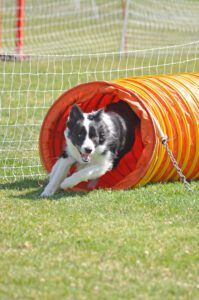
end of a six-foot leash, the controversy over dewclaw removal is somewhat immaterial. If, however, your dog engages in athletic activities that involve hunting, running at speed or making sudden, tight turns and changes of direction, the topic is far more consequential. These activities include not only formal events like agility, flyball, lure coursing, fast CAT (coursing ability test), disc dog sports, hunting, and tracking, but also fun, informal athletic activities like running off-leash, hiking, playing with other dogs, and chasing balls.
What Are Dewclaws and What Do They Do?
For a long time, experts believed that dewclaws served no purpose. They’re located higher up on the limb than the other toes and make no contact with the ground when the dog is standing. As such, it became routine to remove the dewclaws to prevent injuries that dogs sometimes suffer when the dewclaw catches on vegetation as the dog runs, lands from jumps, and turns. The thought was, “If the dewclaws don’t have a function, we might as well get rid of them so that they can never become a problem for the dog.”
This sounds practical, but if you ask veterinarians how often they see dewclaw injuries, they will say hardly ever – or certainly no more frequently than injuries to the other toes. This prompts the question, “If the dewclaws rarely present a problem, why put the dog or puppy through an unnecessary, painful procedure?”
However, if you ask hunting dog breeders or trainers, they will likely say that their dogs suffer dewclaw injuries out in the field frequently enough to warrant surgical removal. Most hunting dog and retriever breeders have their puppies’ dewclaws removed.
Labrador Retriever breeder/trainer Renee Adsitt-Pettey of Peak Performance Labradors in Chaumont, New York, explains: “We remove dewclaws with the sole purpose of preventing torn dewclaws out in the field.” When dogs have dewclaws, she says, “We deal with fairly frequent dewclaw injuries when hunting out of the boat, hunting through thin ice, and wooded marshes.”
Adsitt-Perry adds that dewclaws, at least on her dogs, don’t seem to be as “tight” to the foreleg as they once were, which makes them generally more of a hassle than a help for her dogs.
In contrast, if you ask breeders, trainers, owners, and handlers of agility dogs, they will tell you they never remove dewclaws on their canine athletes. Most agility competitors believe strongly that the dogs’ dewclaws play an important role in helping these athletes safely perform tight turns at speed, help stabilize the limb when the paw contacts the ground after jumps and during turns, and help prevent both acute injuries and the development of chronic arthritis in agility dogs.
How Bad is Dewclaw Removal?
All dogs are born with front dewclaws. (If your dog has no front dewclaws it is likely they were removed soon after birth.)
There is more variability in hind dewclaws. Hind dewclaws are absent in most dogs. In certain breeds, however, hind dewclaws are not only present, but are of impressive size, sometimes double, and are considered functionally important to the breed’s intended purpose (see, “Dog Breeds with Double Dewclaws”).
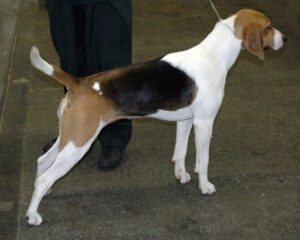
However, on the hind legs, sometimes the dewclaws are “attached” just as they are on the front legs – connected to the adjacent bone by a joint. In other cases, the hind dewclaws have no underlying bony attachment at all; they are joined to the body only by skin. These are called “unattached” dewclaws.
Because unattached dewclaws are loose and floppy with no underlying connection, their functionality is questionable. This is in direct contrast to attached dewclaws, whose functionality is a hot topic among dog breeders, trainers, and veterinarians.
The easiest time to remove dewclaws is two to five days after birth. Virtually none will have bony attachments at that point so it is fairly simple to just snip them off at the base.
Some breeders do this themselves; however, it is best done by a veterinarian who can provide local anesthesia.
For control of bleeding, breeders may use styptic powder. Veterinarians will either place a dissolvable suture to close the wound or use electrocautery, which stops bleeding by mildly burning the tissue. High-end general veterinary practices and specialty practices may have laser surgery, which is the quickest, safest, least painful way to remove dewclaws from newborn puppies.
Some dog owners request the removal of dewclaws on their older puppies and/or adult dogs. Veterinarians will usually provide this service for puppies at the time they are spayed or neutered. In adult dogs it can be performed at any time.
With adult dogs, it’s relatively simple to remove unattached dewclaws; however, it requires general anesthesia. An elliptical incision is made in the skin around the base of the nail, isolating and ligating any blood vessels, removing the nail, and suturing the skin. Most veterinarians will bandage the wounds for a week or so. Some will prescribe antibiotics to prevent infection as the nail is difficult to completely sterilize for surgery. All will send patients home with pain medication.
It’s more difficult to remove attached dewclaws with adult dogs. This is an orthopedic amputation. The incision is bigger, the procedure takes longer, and there is more potential for post-operative pain.
If dewclaw removal is not done properly, the nail may grow back in its entirety, or it may grow back as a misshapen stump. This may be unsightly, but it usually doesn’t cause problems for the dog.
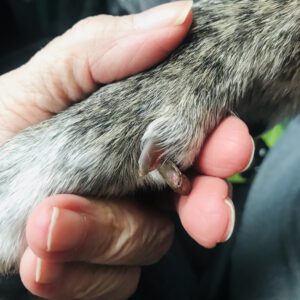
If your dog has dewclaws, remember to pay close attention to trimming them as needed. They may grow faster than your dog’s other nails, as they don’t experience the same wear on the ground as the other nails. Long nails catch on vegetation and break more frequently than short nails (see photo). Also, sometimes dewclaws grow in a curve. If allowed to grow too long your dog may suffer from a painful ingrown toenail.
Dewclaws Do Have a Purpose
So, do dogs need their dewclaws? Little scientific research is available to support or refute the importance of dewclaws in dogs. Most of the discussion is based on general principles of physics and anatomy and anecdotal experience.
The argument that dewclaws have a function is supported by photos and videos of dogs
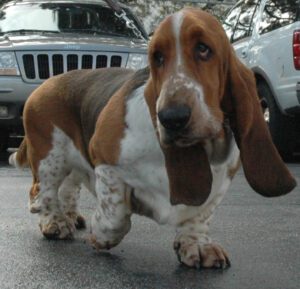
running and/or turning at speed. These images show that dewclaws contact the ground and likely function as a stabilizing force. Stabilizing the foot during these activities helps minimize twisting and over-rotation of the limb, which creates unusual torque and stress on the joints. These forces eventually result in chronic arthritis, particularly in the carpus or “wrist” in dogs.
The dewclaw’s contact with the ground also provides extra traction for the dog to help prevent injury from slipping, helping dogs safely navigate uneven, rocky or icy terrain, and climb steep embankments.
Anatomically, there are five tendons that attach to the dewclaw. When the dewclaw is intact, the muscle bellies of these tendons are well developed, implying they are used on a regular basis. If the dewclaw is removed, these muscles become atrophied. This finding argues toward the dewclaw being an active appendage, not just a useless ornament. Many dogs, even if not athletically inclined, use their dewclaws to grip toys or things they are allowed to chew.
What’s Best For Your Dog is Your Choice
Many breeders and trainers form opinions based on their own experiences, like Adsitt-Pettey and her Labrador hunting dogs. And, there are agility competitors who have had dogs both with and without dewclaws who have repeatedly experienced the development of chronic carpal arthritis in their dogs without dewclaws. While this is not scientific proof, the value of experience gathered by professionals over time with multiple dogs is nothing to ignore.
We all want what’s best for our dogs. Sometimes the answers are not clear cut. In those instances, the best you can do is gather as much information as you can from reputable sources like your veterinarian, your trainer (particularly if you do dog sports), and your potential breeder. It’s up to you to make the best, most educated decision for your dog.
Most dogs with double dewclaws on the hind limbs were bred for guarding or herding livestock. Historically, these extra claws helped them navigate difficult mountainous terrain. The American Kennel Club (AKC) considers double dewclaws a breed standard for the Great Pyrenees, the Beauceron, and the Briard.
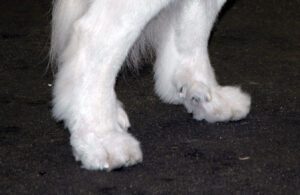
Double dewclaws are frequently seen in the Icelandic Sheepdog, Anatolian Shepherd, and the Spanish Mastiff but they are not considered necessary to meet breed standards.
The Saint Bernard, historically bred for rescue work in the Swiss Alps, frequently has single dewclaws on the hind limbs, occasionally double. While these dewclaws are not a disqualification from AKC competition, they are considered undesirable in this breed.
For some reason, the Bouvier des Flandres, a herding dog from Belgium, must have hind dewclaws removed to meet AKC breed standards.
The Norwegian Lundehund has the most interesting feet of all. Bred to hunt puffin birds in Norway, these dogs would scale rocky cliffs to raid the nests. They have at least six toes on each foot to help them grip the slippery surfaces they climbed. This polydactylism is described in the AKC breed standard for the Norwegian Lundehund.


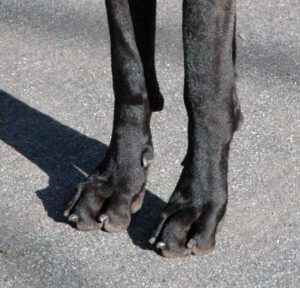




An example of critical need for dew claws: I live in Canada and my doberman jumped in to chase geese in open water on an ice covered lake where we live. Her first attempt to pull herself out failed. She tried again, turning her legs to engage her dew claws and was successful. As an aside, I let it happen as a rescue training event as she could have walked out onto the rock adjoining the open ice and I knew there was 2 ft of solid ice at the deep side. She chose to come directly to me on the deep water side of the ice hole, teaching me that I need to quickly move in line with the best exit spot should it happen again. My guess is she also uses her dew claws when climbing steep bare rock or other challenging terrain. I rarely cut any of her claws as she wears them down herself on ice and rock.
As a contrast, I noticed on dozens of street/beach dogs in Mexico, including the few we adopted when living there that the dew claw was barely attached, dangling from loose skin.